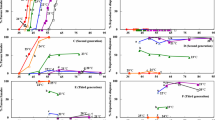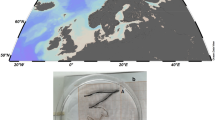Abstract
Under laboratory conditions, the effect of temperature on the reversible arrest in embryo development, which occurs as a result of winter spawning, was studied in the hermit crab Pagurus proximus, Komai, 2000 from Amurskiy Bay (Peter the Great Bay, Sea of Japan). In clutches of females that spawned under natural conditions at a water temperature of 5°C and below, an increase in water temperature to 14–16°C led to the termination of embryonic diapause and the synchronous resumption of egg development, regardless of whether the temperature conditions changed at the beginning or at the end of the winter breeding season. No embryonic diapause was observed in clutches of females of P. proximus that were captured in December–April and spawned in the laboratory at a water temperature of 14–16°С. From this it follows that the primary signal for diapause initiation and termination in P. proximus is temperature, which directly affects the embryo. The data we obtained confirm that embryonic diapause of the hermit crab P. proximus is not obligate but is induced by habitat conditions, primarily by ambient temperature. The possibility of using P. proximus as a model object for studying the mechanisms of embryonic diapause in decapods is considered.

Similar content being viewed by others
REFERENCES
Alekseev, V.R., Physiological and molecular biological mechanisms underlying diapause in aquatic invertebrates, Russ. J. Dev. Biol., 2010, vol. 41, no. 2, pp. 61–70.
Kornienko, E.S., The reproductive strategy of hermit crabs in temperate waters, Russ. J. Mar. Biol., 2020, vol. 46, no. 5, pp. 319–329.
Kornienko, E.S. and Korn, O.M., A key for the identification of the zoeae of common species of hermit crabs (Decapoda: Paguroidea) of Vostok Bay, the Sea of Japan, Russ. J. Mar. Biol., 2016, vol. 42, no. 5, pp. 419–426.
Kornienko, E.S. and Selin, N.I., The population and reproductive characteristics of the hermit crab Pagurus brachiomastus (Thallwitz, 1892) (Decapoda: Paguridae) from Peter the Great Bay, the Sea of Japan, Russ. J. Mar. Biol., 2019, vol. 45, no. 3, pp. 174–184. https://doi.org/10.1134/S1063074019030088
Lotsiya severo-zapadnogo berega Yaponskogo morya ot reki Tumannaya do mysa Belkina (Sailing Directions for the Northwestern Shore of the Sea of Japan: From the Tumannaya River to Cape Belkin), Moscow: Gl. Upr. Navig. Okeanogr., 1984.
Luchin, V.A., Tikhomirova, E.A., and Kruts, A.A., Oceanographic regime of Peter the Great Bay (Sea of Japan), Izv. Tikhookean. Nauchno-Issled. Inst. Rybn. Khoz. Okeanogr., 2005, vol. 140, pp. 130–169.
Selin, N.I., Kornienko, E.S., and Korn, O.M., The species composition and pattern of distribution of hermit crabs (Decapoda: Paguroidea) in Vostok Bay, Sea of Japan, Russ. J. Mar. Biol., 2016, vol. 42, no. 6, pp. 481–488.
Alekseev, V.R., Hwang, J.-S., and Tseng, M.-H., Diapause in aquatic invertebrates: what’s known and what’s next in research and medical application?, J. Mar. Sci. Technol., 2006, vol. 14, no. 4, art. ID 9.
Alekseev, V.R. and Starobogatov, Y.I., Types of diapause in Crustacea: definitions, distribution, evolution, Hydrobiologia, 1996, vol. 320, pp. 15–26.
Alekseev, V.R. and Vinogradova, E.B., Introduction to dormancy in aquatic invertebrates: mechanism of induction and termination, hormonal and molecular-genetic basis, in Dormancy in Aquatic Organisms: Theory, Human Use and Modeling, vol. 92: Monographiae Biologicae, Cham: Springer-Verlag, 2019, pp. 7–41.
Anger, K., The Biology of Decapod Crustacean Larvae, vol. 14: Crustacean Issues, Lisse: A.A. Balkema, 2001.
Baumgartner, M.F. and Tarrant, A.M., The physiology and ecology of diapause in marine copepods, Annu. Rev. Mar. Sci., 2017, vol. 9, pp. 387–411.
Contreras-Garduño, J. and Córdoba-Aguilar, A., Sexual selection in hermit crabs: a review and outlines of future research, J. Zool., 2006, vol. 270, no. 4, pp. 595–605.
Duguid, W.D.P. and Page, L.R., Biennial reproduction with embryonic diapause in Lopholithodes foraminatus (Anomura: Lithodidae) from British Columbia waters, Invertebr. Biol., 2011, vol. 130, no. 1, pp. 68–82.
Fenelon, J.C., Banerjee, A., and Murphy, B.D., Embryonic diapause: development on hold, Int. J. Dev. Biol., 2014, vol. 58, nos. 2–4, pp. 163–174.
Goshima, S., Kawashima, T., and Wada, S., Mate choice by males of the hermit crab Pagurus filholi: Do males assess ripeness and/or fecundity of females?, Ecol. Res., 1998, vol. 13, pp. 151–161.
Goshima, S., Wada, S., and Ohmori, H., Reproductive biology of the hermit crab Pagurus nigrofascia (Anomura: Paguridae), Crustacean Res., 1996, vol. 25, pp. 86–92.
Gyllström, M. and Hansson, L.A., Dormancy in freshwater zooplankton: Induction, termination and the importance of benthic-pelagic coupling, Aquat. Sci., 2004, vol. 66, pp. 274–295.
Hand, S.C., Metabolic Dormancy in Aquatic Invertebrates, vol. 8: Advances in Comparative and Environmental Physiology, New York: Springer-Verlag, 1991, pp. 1–50.
Hand, S.C., Denlinger, D.L., Podrabsky, J.E., and Roy, R., Mechanisms of animal diapause: recent developments from nematodes, crustaceans, insects, and fish, Am. J. Physiol.: Regul., Integr. Comp. Physiol., 2016, vol. 310, no. 11, pp. R1193–R1211.
Hansen, B.W., Copepod embryonic dormancy: “An egg is not just an egg”, Biol. Bull., 2019, vol. 237, no. 2, pp. 145–169.
Jensen, G.C. and Armstrong, D.A., Biennial reproductive cycle of blue king crab, Paralithodes platypus, at the Pribilof Islands, Alaska, and comparison to a congener, P. camtschatica, Can. J. Fish. Aquat. Sci., 1989, vol. 46, pp. 932–940.
Komai, T., Saito, Y., and Myorin, E., A new species of the hermit crab genus Pagurus Fabricius, 1775 (Crustacea: Decapoda: Anomura: Paguridae) from shallow coastal waters in Japan, with a checklist of the East Asian species of the genus, Zootaxa, 2015, vol. 3918, no. 2, pp. 224–238.
Korn, O.M., Kornienko, E.S., and Selin, N.I., Population biology and reproductive characteristics of the hermit crab Pagurus minutus Hess, 1865 (Decapoda: Anomura: Paguridae) in the northern part of the species range (Peter the Great Bay, the Sea of Japan), Mar. Biol. Res., 2018, vol. 14, no. 8, pp. 846–855.
Kornienko, E.S., Selin, N.I., and Korn, O.M., Population and reproductive characteristics of the hermit crab Pagurus proximus Komai, 2000 (Decapoda: Anomura: Paguridae) in the northern part of the species range, J. Mar. Biol. Assoc. U. K., 2019, vol. 99, no. 1, pp. 101–109.
Lovrich, G.A. and Vinuesa, J.H., Reproductive biology of the false southern king crab (Paralomis granulosa, Lithodidae) in the Beagle Channel, Argentina, Fish. Bull., 1993, vol. 91, pp. 664–675.
Mishima, S. and Henmi, Y., Reproduction and embryonic diapause in the hermit crab Pagurus nigrofascia, Crustacean Res., 2008, vol. 37, pp. 26–34.
Mishima S., Kobayashi S., Yamada K., Henmi Y. The effects of photoperiod and temperature on embryonic diapause termination in the hermit crab Pagurus nigrofascia, Plankton Benthos Res., 2021, vol. 16, no. 2, pp. 79–83.
Moriyasu, M. and Lanteigne, C., Embryo development and reproductive cycle in the snow crab, Chionoecetes opilio (Crustacea: Majidae), in the southern Gulf of St. Lawrence, Canada, Can. J. Zool., 1998, vol. 76, no. 11, pp. 2040–2048.
Mura, M., Orrù, F., and Cau, A., Reproduction strategy of the deep-sea hermit crabs Pagurus alatus and Pagurus excavatus of the Central-Western Mediterranean Sea, Hydrobiologia, 2006, vol. 557, pp. 51–57.
Nambu, Z., Tanaka, S., and Nambu, F., Influence of photoperiod and temperature on reproductive mode in the Brine shrimp, Artemia franciscana, J. Exp. Zool., Part A., 2004, vol. 301A, pp. 542–546.
Petersen, S., The embryonic development of Hyas araneus L. (Decapoda, Majidae): Effects of temperature, Sarsia, 1995, vol. 80, no. 3, pp. 193–198.
Podrabsky, J.E. and Hand, S.C., Physiological strategies during animal diapause: lessons from brine shrimp and annual killifish, J. Exp. Biol., 2015, vol. 218, no. 12, pp. 1897–1906.
Reid, W.D.K., Watts, J., Clarke S., et al., Egg development, hatching rhythm and moult patterns in Paralomis spinosissima (Decapoda: Anomura: Paguroidea: Lithodidae) from South Georgia waters (Southern Ocean), Polar Biol., 2007, vol. 30, pp. 1213–1218.
Stevens, B.G., Swiney, K.M., and Buck, L., Thermal effects on embryonic development and hatching for blue king crab Paralithodes platypus (Brandt, 1850) held in the laboratory, and a method for predicting dates of hatching, J. Shellfish Res., 2008, vol. 27, no. 5, pp. 1255–1263.
Swiney, K.M., Egg extrusion, embryo development, timing and duration of eclosion, and incubation period of primiparous and multiparous tanner crabs (Chionoecetes bairdi), J. Crustacean Biol., 2008, vol. 28, no. 2, pp. 334–341.
Turra, A. and Leite, F.P.P., Embryonic development and duration of incubation period of tropical intertidal hermit crabs (Decapoda, Anomura), Rev. Bras. Zool., 2007, vol. 24, no. 3, pp. 677–686.
Wada, S. and Mima, A., Reproductive characters of the hermit crab Pagurus proximus Komai, 2000 in Hakodate Bay, southern Hokkaido, Japan, Crustacean Res., 2003, no. 32, pp. 73–78.
Wada, S., Oba, T., Nakata, K., and Ito, A., Factors affecting the interval between clutches in the hermit crab Pagurus nigrivittatus, Mar. Biol., 2008, vol. 154, no. 3, pp. 501–507.
Wada, S., Tanaka, K., and Goshima, S., Precopulatory mate guarding in the hermit crab Pagurus middendorffii (Brandt) (Decapoda: Paguridae): effects of population parameters on male guarding duration, J. Exp. Mar. Biol. Ecol., 1999, vol. 239, no. 2, pp. 289–298.
Wang, Z., Asem, A., Okazaki, R.K., and Sun, S., The critical stage for inducing oviparity and embryonic diapause in parthenogenetic Artemia (Crustacea: Anostraca): an experimental study, J. Oceanol. Limnol., 2019, vol. 37, no. 5, pp. 1669–1677.
Wear, R.G., Incubation in British decapod Crustacea, and the effects of temperature on the rate and success of embryonic development, J. Mar. Biol. Assoc. U. K., 1974, vol. 54, no. 3, pp. 745–762.
Webb, J.B., Eckert, G.L., Shirley, T.C., and Tamone, S.L., Changes in embryonic development and hatching in Chionoecetes opilio (snow crab) with variation in incubation temperature, Biol. Bull., 2007, vol. 213, no. 1, pp. 67–75.
Zadereev, E. and Lopatina, T.S., The role of chemical interactions in embryonic diapause induction in zooplankton, in Dormancy in Aquatic Organisms, Theory, Human Use and Modeling, vol. 92: Monographiae Biologicae, Cham: Springer-Verlag, 2019, pp. 175–186.
ACKNOWLEDGMENTS
The author is grateful to the team of the Diving Department of the National Scientific Center of Marine Biology of the FEB RAS, who captured hermit crabs under difficult winter conditions, as well as to the staff of the Aquarium Department for long-term maintenance of the animals.
Author information
Authors and Affiliations
Corresponding author
Ethics declarations
Conflict of interests. The author declares that she has no conflict of interest.
Statement on the welfare of animals. All applicable international, national, and/or institutional guidelines for the care and use of animals were followed.
Additional information
Translated by T. Koznova
Rights and permissions
About this article
Cite this article
Kornienko, E.S. A Laboratory Study of the Effect of Temperature on the Embryonic Diapause of the Hermit Crab Pagurus proximus Komai, 2000 (Decapoda: Paguridae) from Peter the Great Bay, Sea of Japan. Russ J Mar Biol 48, 231–237 (2022). https://doi.org/10.1134/S1063074022040058
Received:
Revised:
Accepted:
Published:
Issue Date:
DOI: https://doi.org/10.1134/S1063074022040058




